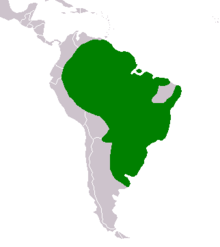Capybara
| Capybara | |
|---|---|
 |
|
| Scientific classification | |
| Kingdom: | Animalia |
| Phylum: | Chordata |
| Clade: | Synapsida |
| Class: | Mammalia |
| Order: | Rodentia |
| Family: | Caviidae |
| Subfamily: | Hydrochoerinae |
| Genus: | Hydrochoerus |
| Species: | H. hydrochaeris |
| Binomial name | |
|
Hydrochoerus hydrochaeris (Linnaeus, 1766) |
|
 |
|
| Range | |
The capybara (Hydrochoerus hydrochaeris) is the largest rodent in the world. It is a member of the genus Hydrochoerus, of which the only other extant member is the lesser capybara (Hydrochoerus isthmius). Close relatives are guinea pigs and rock cavies, and it is more distantly related to the agouti, chinchillas, and the coypu. Native to South America, the capybara inhabits savannas and dense forests and lives near bodies of water. It is a highly social species and can be found in groups as large as 100 individuals, but usually lives in groups of 10–20 individuals. The capybara is not a threatened species and is hunted for its meat and hide and also for a grease from its thick fatty skin which is used in the pharmaceutical trade.
Its common name is derived from Tupi ka'apiûara, a complex agglutination of kaá (leaf) + píi (slender) + ú (eat) + ara (a suffix for agent nouns), meaning "one who eats slender leaves", or "grass-eater". The scientific name, both hydrochoerus and hydrochaeris, comes from Greek ὕδωρ (hydro" = water) + χοίρος (choiros = pig, hog).
The capybara and the lesser capybara belong to the subfamily Hydrochoerinae along with the rock cavies. The living capybaras and their extinct relatives were previously classified in their own family Hydrochoeridae. Since 2002, molecular phylogenetic studies have recognized a close relationship between Hydrochoerus and Kerodon supporting placement of both genera in a subfamily of Caviidae. Paleontological classifications have yet to incorporate this new taxonomy and continue to use Hydrochoeridae for all capybaras, while using Hydrochoerinae for the living genus and its closest fossil relatives, such as Neochoerus. The taxonomy of fossil hydrochoerines is also in a state of flux. In recent years, the diversity of fossil hydrochoerines has been substantially reduced. This is largely due to the recognition that capybara molar teeth show strong variation in shape over the life of an individual. In one instance, material once referred to four genera and seven species on the basis of differences in molar shape is now thought to represent differently aged individuals of a single species, Cardiatherium paranense.
...
Wikipedia

